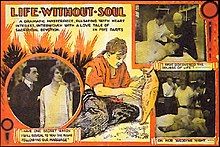
John William Polidori was a British writer and physician. He is known for his associations with the Romantic movement and credited by some as the creator of the vampire genre of fantasy fiction. His most successful work was the short story "The Vampyre" (1819), the first published modern vampire story. Although the story was at first erroneously credited to Lord Byron, both Byron and Polidori affirmed that the author was Polidori.
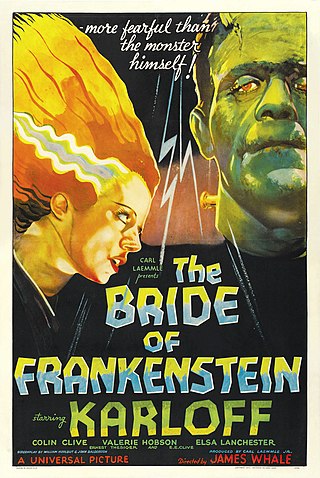
Bride of Frankenstein is a 1935 American science fiction horror film, and the first sequel to Universal Pictures' 1931 film Frankenstein. As with the first film, Bride of Frankenstein was directed by James Whale starring Boris Karloff as the Monster and Colin Clive as Dr. Frankenstein. The sequel features Elsa Lanchester in the dual role of Mary Shelley and the bride. Colin Clive reprises his role as Henry Frankenstein, and Ernest Thesiger plays the role of Doctor Septimus Pretorius. Oliver Peters Heggie plays the role of the old blind hermit.

Frankenstein is a 1931 American pre-Code science fiction horror film directed by James Whale, produced by Carl Laemmle Jr., and adapted from a 1927 play by Peggy Webling, which in turn was based on Mary Shelley's 1818 novel Frankenstein; or, The Modern Prometheus. The Webling play was adapted by John L. Balderston and the screenplay written by Francis Edward Faragoh and Garrett Fort, with uncredited contributions from Robert Florey and John Russell.

Frankenstein's monster or Frankenstein's creature, also commonly known as Frankenstein, is a fictional character who first appeared in Mary Shelley's 1818 novel Frankenstein; or, The Modern Prometheus as the main antagonist. Shelley's title thus compares the monster's creator, Victor Frankenstein, to the mythological character Prometheus, who fashioned humans out of clay and gave them fire.
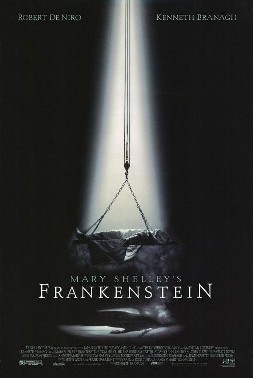
Mary Shelley's Frankenstein is a 1994 science fiction horror film directed by Kenneth Branagh who also stars as Victor Frankenstein, with Robert De Niro portraying Frankenstein's monster, and co-stars Tom Hulce, Helena Bonham Carter, Ian Holm, John Cleese, Richard Briers and Aidan Quinn. Considered the most faithful film adaptation of Mary Shelley's 1818 novel, Frankenstein; or, The Modern Prometheus, despite several differences and additions in plot from the novel, the film follows a medical student named Victor Frankenstein who creates new life in the form of a monster composed of various corpses' body parts.

Frankenstein is a 1910 American short silent horror film produced by Edison Studios. It was directed by J. Searle Dawley, who also wrote the one-reeler's screenplay, broadly basing his "scenario" on Mary Shelley's 1818 novel Frankenstein; or, The Modern Prometheus. This short motion picture is generally recognized by film historians as the first screen adaptation of Shelley's work. The small cast, who are not credited in the surviving 1910 print of the film, includes Augustus Phillips as Dr. Frankenstein, Charles Ogle as Frankenstein's monster, and Mary Fuller as the doctor's fiancée.

Victor Frankenstein is a fictional character and the main protagonist and title character in Mary Shelley's 1818 novel, Frankenstein; or, The Modern Prometheus. He is a Swiss scientist who, after studying chemical processes and the decay of living things, gains an insight into the creation of life and gives life to his own creature. Victor later regrets meddling with nature through his creation, as he inadvertently endangers his own life and the lives of his family and friends when the creature seeks revenge against him. He is first introduced in the novel when he is seeking to catch the monster near the North Pole and is saved from near death by Robert Walton and his crew.
Dr. Waldman is a fictional character who appears in Mary Shelley's 1818 novel, Frankenstein; or, The Modern Prometheus and in its subsequent film versions. He is a professor at Ingolstadt University who specializes in chemistry and is a mentor of Victor Frankenstein.
Dean Koontz's Frankenstein is the collective title of five novels co-written by Dean Koontz. Though technically of the mystery or thriller genres, the novels also feature the trappings of horror, fantasy, and science fiction.
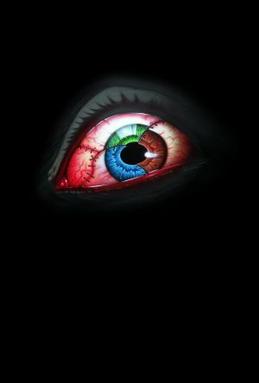
Frankenstein Unbound is a 1990 science fiction horror film based on Brian Aldiss' 1973 novel of the same name, starring John Hurt, Raul Julia, Bridget Fonda, Jason Patric, and Nick Brimble. The film is co-written and directed by Roger Corman, returning to the director's chair after a hiatus of almost twenty years. This is his final directorial effort to date, for which he was paid $1 million to direct.
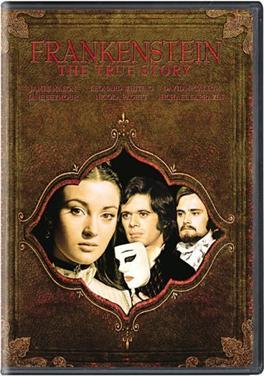
Frankenstein: The True Story is a 1973 British made-for-television film loosely based on the 1818 novel Frankenstein; or, The Modern Prometheus by Mary Shelley. It was directed by Jack Smight, and the screenplay was written by novelist Christopher Isherwood and his longtime partner Don Bachardy.

Mary Shelley's 1818 novel Frankenstein; or, The Modern Prometheus, and the famous character of Frankenstein's monster, have influenced popular culture for at least a century. The work has inspired numerous films, television programs, video games and derivative works. The character of the Monster remains one of the most recognized icons in horror fiction.
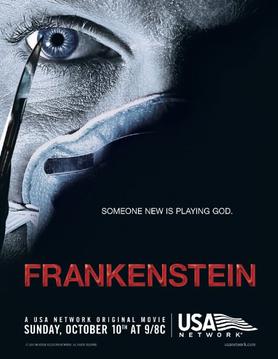
Frankenstein is a 2004 American science fiction horror television film produced and directed by Marcus Nispel and written by John Shiban. It is a loose adaptation of Mary Shelley's Frankenstein, and stars Parker Posey as a police detective on the trail of a serial killer, played by Thomas Kretschmann, in present-day New Orleans. The detective is aided in her search by one of the killer's creations, played by Vincent Perez. Adam Goldberg, Ivana Miličević and Michael Madsen co-star. It was produced by Lions Gate Films, and aired on the USA Network on October 10, 2004.

Frankenstein; or, The Modern Prometheus is an 1818 novel written by English author Mary Shelley. Frankenstein tells the story of Victor Frankenstein, a young scientist who creates a sapient creature in an unorthodox scientific experiment. Shelley started writing the story when she was 18, and the first edition was published anonymously in London on 1 January 1818, when she was 20. Her name first appeared in the second edition, which was published in Paris in 1821.

Frankenstein is a television horror film first aired in 1992, based on Mary Shelley's 1818 novel Frankenstein; or, The Modern Prometheus. It was produced by Turner Pictures and directed by David Wickes.

Mary Wollstonecraft Shelley was an English novelist who is best known for writing the Gothic novel Frankenstein; or, The Modern Prometheus (1818), which is considered an early example of science fiction. She also edited and promoted the works of her husband, the Romantic poet and philosopher Percy Bysshe Shelley. Her father was the political philosopher William Godwin and her mother was the philosopher and women's rights advocate Mary Wollstonecraft.

Rowing with the Wind a.k.a. Remando al viento is a 1988 Spanish film written and directed by Gonzalo Suárez. The film won seven Goya Awards. It concerns the English writer Mary Shelley and her circle.
English writer Lord Byron has been mentioned in numerous media. A few examples of his appearances in literature, film, music, television and theatre are listed below.

Frankenstein is a 2015 American science fiction horror film written and directed by Bernard Rose. It is a modernised adaptation of Mary Shelley's 1818 novel Frankenstein; or, The Modern Prometheus. The film is told from the monster's point of view, as he is created, escapes into the modern world, and learns about the dark side of humanity.

Since the initial publication of Mary Wollstonecraft Shelley's novel Frankenstein; or, The Modern Prometheus in 1818, there has existed uncertainty about the extent to which Mary Shelley's husband, Percy Bysshe Shelley, contributed to the text. Whilst the novel was conceived and mainly written by Mary, Percy is known to have provided input in editing and publishing the manuscript. Some critics have alleged that Percy had a greater role—even the majority role—in the creation of the novel, though mainstream scholars have generally dismissed these claims as exaggerated or unsubstantiated. Based on a transcription of the original manuscript, it is currently believed that Percy contributed between 4,000 and 5,000 words to the 72,000 word novel.
